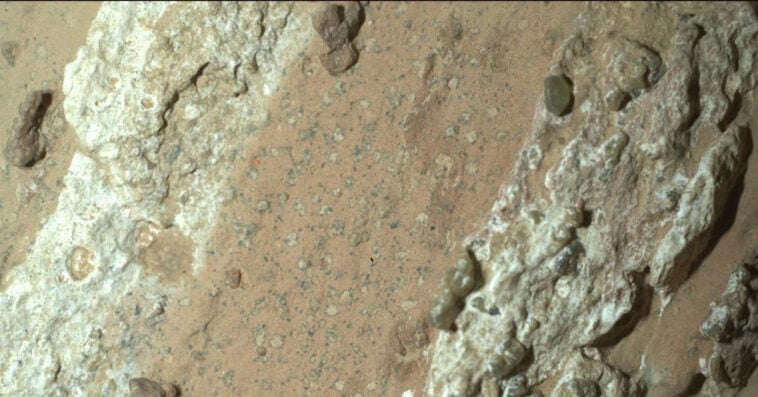For decades, scientists have scoured Mars for even the faintest trace of life—and now, an intriguing, speckled rock may have delivered the most compelling clue yet. A freshly analyzed sample collected by NASA’s Perseverance rover reveals unusual markings and minerals that could point to ancient microbes once thriving on the Red Planet. While researchers caution that only further testing on Earth can confirm the find, the discovery has ignited fresh hope that Mars was never truly barren. Could this be the breakthrough that finally confirms the age-old question of whether life exists beyond Earth?
Sapphire Canyon sample could hold signs of ancient Martian life
At a news conference held on Wednesday, September 10, NASA announced that a Martian rock sample marked with leopard-like spots could hold one of the clearest hints yet of ancient life. Collected by the Perseverance rover in July 2024, the sample—named Sapphire Canyon—has been the subject of intense study. A newly published paper in Nature details the findings, though scientists stress that further research is needed before any final conclusions can be made.
Sapphire Canyon was drilled from Cheyava Falls, an arrowhead-shaped rock on the edge of the Neretva Vallis. This ancient river valley once carried water into Jezero Crater more than 3 billion years ago. Perseverance landed inside the crater in 2021 to investigate rocks shaped by water in hopes of uncovering traces of past life.
Though the sample remains sealed inside a tube millions of miles away on Mars, its unusual markings continue to intrigue researchers. The central mystery: were these spots formed by ordinary chemical reactions, or could they be remnants of microscopic organisms that once lived on the Red Planet?
“Today, we are really showing you how we are kind of one step closer to answering humanity’s one of their most profound questions, and that is, are we truly alone in the universe?” said Nicky Fox, associate administrator for NASA’s Science Mission Directorate.
Living microbes or chemical reactions? What caused Cheyava Falls’ mysterious spots
The new study lays out two possible explanations for the unusual patterns on the surface of the Martian rock: they could have been formed by life, or by natural chemical processes without it. One idea is that the features might have developed from reactions between organic material and iron. But according to researcher Michael Tice, that process usually requires high heat—something not seen in this sample.
“All the ways we have of examining these rocks on the rover suggest that they were never heated in a way that could produce the leopard spots and poppy seeds,” Tice explained. “If that’s the case, we have to seriously consider the possibility that they were made by creatures like bacteria living in the mud in a Martian lake more than three billion years ago.”
Scientists believe Cheyava Falls, where the sample was drilled, may have started out as mud mixed with organic compounds that later hardened into rock. Over time, water may have seeped into cracks, leaving behind minerals that created the veins and the distinctive leopard-like spots.
“What’s exciting about these finds, this sort of combination of mud and organic matter that has reacted to produce these minerals and these textures, is that when we see features like this are often the byproduct of microbial metabolisms that are consuming organic matter and making these minerals as a result of those reactions,” said geoscientist Joel Hurowitz.
Even so, Hurowitz added that the possibility of nonbiological explanations can’t be ruled out.
NASA’s biggest hurdle: Bringing Sapphire Canyon to Earth
While the discovery is promising, scientists stress that the real answers lie in bringing the rock sample back to Earth. “What we need to do from here is to continue to do additional research in laboratory settings here on Earth, and ultimately bring the sample from this rock back home to Earth, so that we can make the final determination for what process actually gave rise to these fantastic textures,” Hurowitz said.
That step, however, comes with big obstacles. NASA is facing uncertainty about how to carry out a sample-return mission as the White House pushes to cut the agency’s science budget by nearly half. “We’re looking at how we get the sample back, or other samples back,” said Acting NASA Administrator Sean Duffy. “What we’re going to do is look at our budgets, we look at our timing, and you know, how do we spend money better, and you know, what technology do we have to get samples back more quickly? And so that’s a current analysis that’s happening right now.”
Despite the funding challenges, researchers insist that returning the sample is essential. Only then can they use the most advanced Earth-based tools to determine if life ever truly existed on Mars. “Bringing this sample back to Earth would allow us to analyze it with instruments far more sensitive than anything we can send to Mars,” Tice explained. “What’s fascinating is how life may have been making use of some of the same processes on Earth and Mars at around the same time. It’s a special and spectacular thing to be able to see them like this on another planet.”

